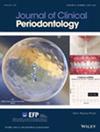心理应激和应激相关疾病对牙周炎治疗结果的影响:一项系统综述和荟萃分析
IF 6.8
1区 医学
Q1 DENTISTRY, ORAL SURGERY & MEDICINE
引用次数: 0
摘要
背景和目的在16岁及以上的牙周炎患者(人群)中,在实验研究或描述性前后研究(研究设计)中观察到的心理压力和压力相关疾病(PSRD;暴露)与没有PSRD的患者相比如何影响牙周炎治疗的临床依恋水平(CAL)(结果)?方法检索5个主要数据库,包括前后研究、描述性队列和准实验或随机对照试验(rct)。对于meta分析,CAL和探查出血(BOP)的平均差异与随机效应模型合并。评估偏倚风险、研究质量和证据的确定性。结果共纳入13项研究(8项前瞻性研究、2项回顾性研究、2项准实验研究和1项先导随机对照研究),共纳入1610名受试者。PSRD(在9项研究中测量为压力,在3项研究中测量为抑郁,在1项研究中测量为焦虑)对牙周炎治疗(步骤1 + 2:8项研究,步骤1 + 2 + 3或4:4项研究,步骤4:1项研究)结果有负面影响。步骤1 + 2治疗结果的荟萃分析显示,与未接受治疗的患者相比,PSRD(暴露:压力)患者的CAL减少幅度较小(3项研究,n = 170,加权平均差(WMD) = 0.78 mm;p = 0.01)和探测袋深度(PPD; 3项研究;n = 170; WMD = 1.02 mm; p = 0.04)。结论psrd对牙周炎治疗结果有不利影响,尤其是CAL和PPD,尽管我们对CAL的效果估计的信心有限,而对PPD的效果估计的信心很低。这一结论是基于小型治疗队列和准实验研究,在3-6个月的时间内进行牙周炎治疗的第1 + 2步,需要通过严格设计的研究来验证。本文章由计算机程序翻译,如有差异,请以英文原文为准。
The Influence of Psychological Stress and Stress‐Related Disorders in the Treatment Outcome of Periodontitis: A Systematic Review and Meta‐Analysis
Background and ObjectiveIn humans 16 years and above with periodontitis (Population), how do psychological stress and stress‐related disorders (PSRD; Exposure) compared to those without PSRD (Comparison) affect clinical attachment level (CAL) upon periodontitis treatment (Outcome), as observed in experimental studies or descriptive pre–post studies (Study design)?MethodsFive major databases were searched for pre–post studies, descriptive cohort and quasi‐experimental or randomised controlled trials (RCTs). For meta‐analysis, mean differences in CAL and bleeding on probing (BOP) were pooled with random‐effects models. Risk of bias, study quality and certainty of evidence were assessed.ResultsThirteen studies (eight prospective, two retrospective, two quasi‐experimental and one pilot RCT) with 1610 participants were identified. PSRD (measured as stress in nine studies, depression in three studies and anxiety in one study) showed a negative influence on periodontitis treatment (steps 1 + 2: eight studies, steps 1 + 2 + 3 or 4: four studies, step 4: one study) outcomes. Meta‐analysis of steps 1 + 2 treatment results revealed that patients with PSRD (exposure: stress)—compared to those without—had smaller reductions in CAL (three studies; n = 170; weighted mean difference (WMD) = 0.78 mm; p = 0.01) and probing pocket depth (PPD; three studies; n = 170; WMD = 1.02 mm; p = 0.04) following periodontitis treatment in studies.ConclusionPSRD adversely affected periodontitis treatment outcomes, particularly concerning CAL and PPD, even though our confidence in the effect estimate is limited in the case of CAL and very low in the case of PPD. This conclusion, based on small treatment cohorts and quasi‐experimental studies following steps 1 + 2 of periodontitis treatment over a 3–6‐month period, warrants validation through rigorously designed studies.
求助全文
通过发布文献求助,成功后即可免费获取论文全文。
去求助
来源期刊

Journal of Clinical Periodontology
医学-牙科与口腔外科
CiteScore
13.30
自引率
10.40%
发文量
175
审稿时长
3-8 weeks
期刊介绍:
Journal of Clinical Periodontology was founded by the British, Dutch, French, German, Scandinavian, and Swiss Societies of Periodontology.
The aim of the Journal of Clinical Periodontology is to provide the platform for exchange of scientific and clinical progress in the field of Periodontology and allied disciplines, and to do so at the highest possible level. The Journal also aims to facilitate the application of new scientific knowledge to the daily practice of the concerned disciplines and addresses both practicing clinicians and academics. The Journal is the official publication of the European Federation of Periodontology but wishes to retain its international scope.
The Journal publishes original contributions of high scientific merit in the fields of periodontology and implant dentistry. Its scope encompasses the physiology and pathology of the periodontium, the tissue integration of dental implants, the biology and the modulation of periodontal and alveolar bone healing and regeneration, diagnosis, epidemiology, prevention and therapy of periodontal disease, the clinical aspects of tooth replacement with dental implants, and the comprehensive rehabilitation of the periodontal patient. Review articles by experts on new developments in basic and applied periodontal science and associated dental disciplines, advances in periodontal or implant techniques and procedures, and case reports which illustrate important new information are also welcome.
 求助内容:
求助内容: 应助结果提醒方式:
应助结果提醒方式:


